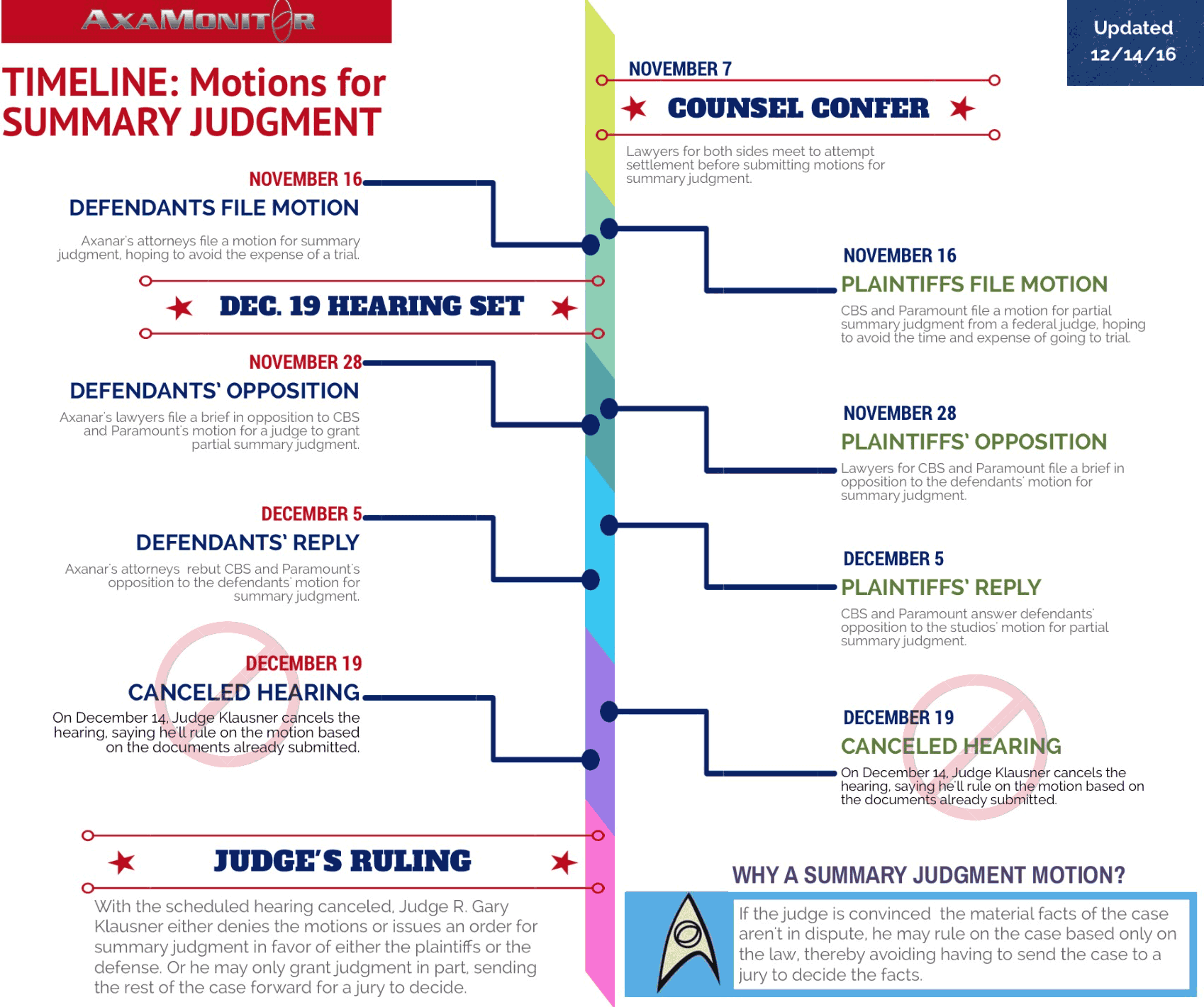This is an old revision of the document!
Table of Contents
Explainer
Motions for Summary Judgment
Both sides in Axanar’s Star Trek copyright infringement suit signaled their intent in May to seek a summary judgment from U.S. district court Judge Gary Klauser in motions expected by November 16, 2016.
Early End to Lawsuit

A motion for summary judgment is a means for one party bring an early end to a lawsuit:
[The motion] is a request for the court to rule that the other party has no case, because there are no facts at issue. The party making the motion is claiming that either the case should not go before a jury at all, or a jury could only rule in favor of the moving party.
In order to win an [motion for summary judgment], the moving party must show that:
• There are no facts which can reasonably be disputed; or
• Anyone looking at the facts and applying law would rule in favor of the moving party.1)
In Axanar’s case, both its attorney and lawyers for plaintiffs CBS and Paramount planned to submit their own summary judgment motion, requiring a complicated exchange of legal briefs, as shown in the timeline below.
Timeline
Federal courts follow rules outlining deadlines for the legal filings required to support summary judgment motions.  The timeline below describes what happens at each stage of consideration for the motions, with each side allowed to argue against the other’s motion, and then to rebut the opposition. Finally, the attorneys deliver oral arguments before Judge Klausner.
The timeline below describes what happens at each stage of consideration for the motions, with each side allowed to argue against the other’s motion, and then to rebut the opposition. Finally, the attorneys deliver oral arguments before Judge Klausner.
What's In the Motion?
Under the Federal Rules for Civil Procedure, and the additional local rules in the Central California District, each motion for summary judgment must include a:
- Proposed “Statement of Uncontroverted Facts and Conclusions of Law,” asserting the material facts to which there is no genuine dispute.
- Proposed judgment being sought.2)
- Statement declaring the two sides conferred at least seven days before submitting the motion and were unable to figure out a way to resolve their differences.3)

Attorneys for Axanar and for the studios have met several times in recent weeks as part of court-mandated settlement talks. Their most recent meeting was scheduled November 14, two days before the cut-off date for submitting the motions.
Partial Judgment
The rules also allow each party submitting a motion to request the judge rule just on specific individual claims, defenses, or issues if partial summary judgment is sought.
Filed by Opposing Party
The opposing side must submit its own document, a “Statement of Genuine Disputes of Material Fact by Opposing Party,” which details all material facts to which it believes there is a genuine dispute.4)
In response to the studios’ legal complaint, Axanar filed a counterclaim in May, and it’s likely the defendants will use the counterclaim as the basis for their own motion for summary judgment.
Undisputed Facts
Each side marshals the proof it has gathered from discovery, compares it to evidence presented by opposing counsel and argues before the judge that the material facts of the case are not disputed:
Summary judgment is awarded if the undisputed facts and the law make it clear that it would be impossible for the opposing party to prevail if the matter were to proceed to trial.5)
By filing its own similar motion, Axanar assumes the burden of proof to show the studios lack evidence to prove their claims.
Evidence at Last
For each side to prevail over the opposing motions, it “will need to present the judge with evidence that a jury could use to find in [its] favor.”6)
A party is allowed to use all of the information obtained during the discovery phase of the lawsuit, including, without limitation, deposition testimony, answers to interrogatories and answers to requests for production. The parties may also utilize affidavits from experts to support the motion or opposition to the motion for summary judgment.7)
According to the federal court’s local rules the court could call for witness testimony in the hearing.8)
The motions and subsequent hearing will mark the first public disclosure of at least some of the potential evidence gathered by both sides in discovery, which concluded on November 2.
Factual Disputes
Disputed facts will stop a summary judgment dead in its tracks. The judge must be convinced that the alleged facts are proven, freeing him to only consider the law to make his ruling. However, not every fact presented by either side must be proven, only those material to the case:
“By its very terms, this [legal] standard provides that the mere existence of some alleged factual dispute between the parties will not defeat an otherwise properly supported motion for summary judgment; the requirement is that there be no genuine issue of material fact.”9)
If the judge issues a summary judgment, the losing party can appeal the decision to the Ninth Circuit Court of Appeals.
Shifting Burden of Proof
Normally, a civil case places the burden of proof on the plaintiffs, and that’s still true with the motion for summary judgment submitted by the studios against Axanar. However, by filing its own similar motion, the defense assumes the burden of proof to show the plaintiffs lack evidence to prove their claims.
Hearing and Judge's Decision
Once the parties have filed their documents related to the summary judgment motion, the judge holds a hearing, including arguments from both sides, followed by a ruling either granting the motion for summary judgment — which ends the case against the moving party — or denying it, which allows the case to go forward, and on to trial if no settlement is reached.
Appeal
If the judge grants a motion for summary judgment, the case is effectively ended. However, the losing party can appeal the decision to the Ninth Circuit Court of Appeals.
The court of appeal can reverse the grant of summary judgment and reinstate the claim in the lower court. However, this is rarely done and most summary judgments are upheld on appeal.10)

Keywords



